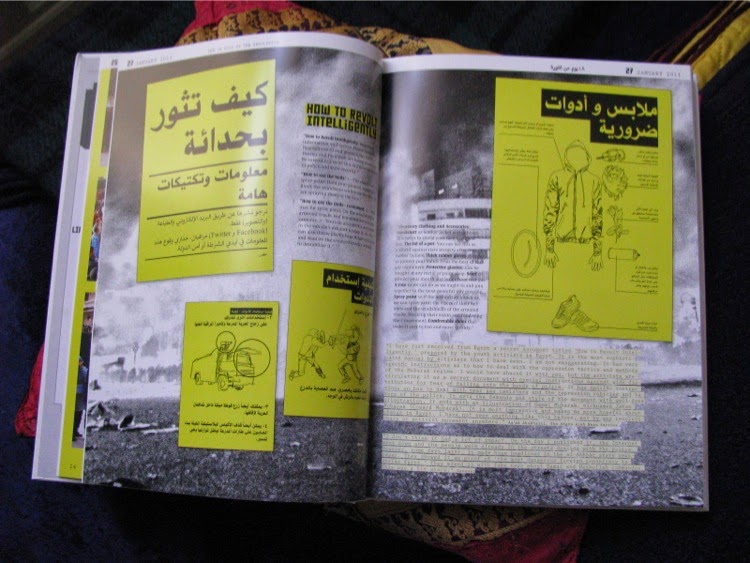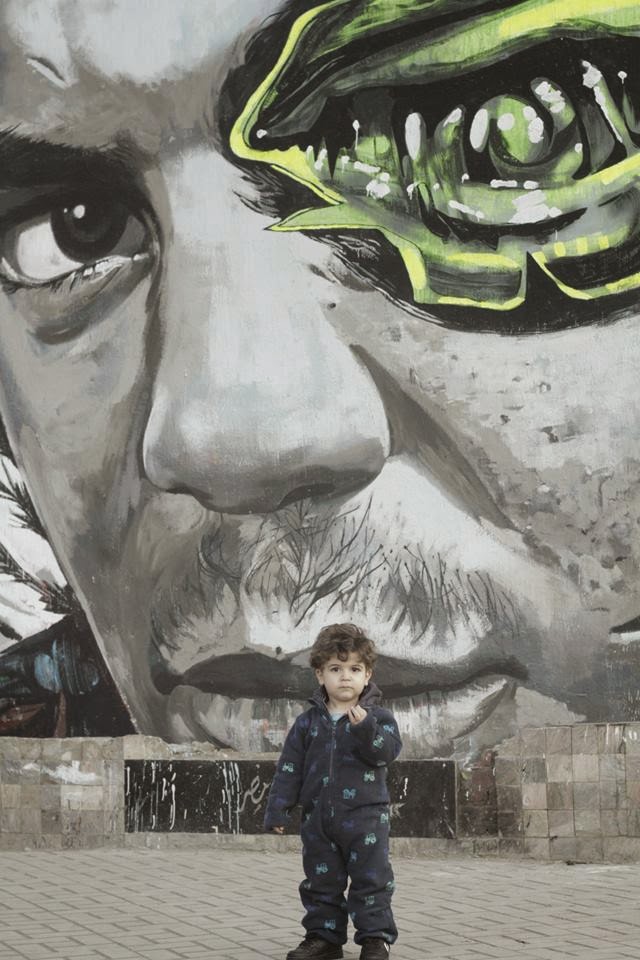Walls of Freedom
 |
| The spread from Walls of Freedom on "How to Revolt Intelligently" by Ganzeer, January 27, 2011. |
The agenda has been distributed widely and used by new groups taking to the streets since 2006. I could not help thinking of it when seeing Ganzeer's "How to Revolt Intelligently" from the first days of the revolution in Egypt, on how to make it possible to take to the streets with the minimum of injury and arrest resulting from it.
 |
| The basic necessities when painting graffiti while being attacked by tear gas, not forgetting the rose Ganzeer, "How to Revolt Intelligently", January 27, 2011 |
 |
| NeMo: Three years on we still only have one weapon, January 21, 2014. |
And yet, the uprisings in 2011 won their strength from combining one of the oldest means of communicating - writing on the walls surrounding us - with the platforms of the electronic media. It turned out to be not just a necessary, but an efficient strategy, as Rana Jarbou writes in her wonderful article in the gorgeous new book on the street art of Egypt of the past three years: Walls of Freedom.
The streets of Cairo lacked presence, as Rana Jarbou tell us. They contained a past, but not the present. The graffiti artists, of which Kareem Lotfy and Ganzeer were pioneers, took to the walls, creating what grew into an urban discourse
 |
| Walls of Fredom; Street Art of the Egyptian Revolution, Witten by Don Karl and Basma Hamdy, 2014. Published by From Here to Fame Publishing - from where it can be ordered. |
 |
| A spread from Walls of Freedom on the first 18 days of revoultion |
Basma Hamdy and Don Karl have managed the impossible: How to document the many layers of political, personal and artistic outpourings, the developments, the set backs, the artistic initiatives and so much, much more, creating a progressive story closely linked to the specific dates, when each event took place. This alone will make the book an invaluable Encyclopedia of an important chapter in the art history of our time.
 |
| Section of the wall in Mohamed Mahmoud Street with at least three layers of graffiti, the top layer is by Ammar Abu Bakr, captured March 27, 2014. Photo: SOoOti eYes. |
 |
| A wider wiev of the same section of the wall, with the works of Ammar Abu Bakr as the top layers, Photo: Abdelrhman Zin Eldin, December 5, 2013. |
By portraying the people they gave a special poignancy to the meaning of presence in the street, and even if the first layers have been replaced, they can still be seen when the light is right, as can be seen in the photo by SOoOti eYes. This one photo is the epitome of the Egyptian history of the past three years.
 |
| A spread from Walls of Freedom, the posters shown are by Ganzeer. |
"Imagine, wrote the Danish artist Frans Schwartz in a private letter around 1880, Tolstoy, Dostojevskij and Kropotkin are alive and writing this very instant in the history of mankind and I am their contemporary".
He and his friends were frenetically busy whenever a new book was published, grabbing it in the translation first at hand, usually the French or German ones, even devouring them in the translations, which came later to compare specific paragraphs. The authors constituted the genuine now, however painful the contents of their writings, on poverty or the wronged man, making their readers feel they were the imprisoned or starving ones.
It feels such a privilege that we now know what he meant. Aya Tarek, Ammar Abo Bakr, Abood, Ganzeer, NeMo, Naguib, Alaa Awaad, Mohammed Khaled - just to mention a few. Each of them with a very personal voice different from those of their colleagues and with an outstanding talent of which we have only seen the beginning.
 |
| Ammar Abu Bakr, the portrait of Bassem Mohsen at the corner at Mohamed Mahmoud Street, Photo: Abdelrhman Zin Eldin, January 19, 2014. |
All artworks and photos shown are courtesy of their artists and photographers and must not be reproduced without their permission.


